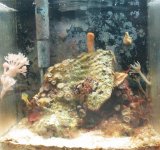That's very good information to further our guesses on the controls and input of nutrients into your pico. I think a minor role could be played by not adhering to the water changes during the intial phase of the reef, but this is not catastophic and can be fixed with patience. IMO if you have any substrate, this would be a time of storing up a few initial bits of protein and detritus to start the episodes we see now. The LR (which also catches and stores waste particulate matter depending on circulation and cleaning habits) and various surfaces might have tiny/miniscule population blooms of whatever benthic microorganisms enjoyed this surplus--> as they dieoff and re-emerge based on nutrient availability, seeking population equilibrium, I think this is also played a role in the acitivity you see today. In my opinion, this is a further cycling of live rock to be selective for the environment at hand... in your case a mighty small one! I don't have any hardcore written experimental data to back all this up it's just what I gather from my slew of picos over the years.
It is true that coral-only systems have the lowest continual bioload, and IMO don't even count as bioload in larger nanos and reefs (due to dilution, can you believe we are using that word in the context of nano-reefs!) but in our
sub-gallon picos they really do have comparable nitrate accumulation trends to fish-laden larger systems for a given amount of time... in other words, coral-only picos accumulate waste too, just in very 'trace' amounts relative to what it would take to tip the nitrate scales in say a 10 or 20 gallon reef tank. Most keepers time their water changes to the nitrogen accumulation maximums, and in all my picos I tended to reach them in a week's time even with minimal feedings. I also found partial water changes weren't enough to export that based on accumulation rates IMO. What I used to think was an acceptable nitrate range was also too much (I let it get up to 20 ppm usually)-now I'm super strict in the hopes of keeping this rascal alive and clean for years. Only time will tell@
I think rcsheng summed it up best with his reply, incorporating DMohr's circulation mention, that there are still protein liberations and subsequent ammonia/nitrogen cycle activities going on in the aged pico reef which is where your nutrients are stored and being released into those cyano mats...
Also, by 'feeding' I also don't mean literally feeding pellets to shrimp or other animals, it could be feed/protein support as introduced by those that don't dose their systems but add water from established reef systems, ie used water (but still cleaner than old pico water). Fresh/new SW is protein-free or as close to it as we'll get...and I think the use of it affords the longest interval time in between water changes, if nitrate clearance is the standard (other popular water change indic
ators for typical reefs could be micronutrients consumed where the wc replaces them).
I don't feed my tank any more than once per week, and its a mighty small portion. I use a small bit of DT's reef eggs, for their protein, and switch it out with cyclopeeze from time to time. I add DT's also once per week in small drops. In my experience, even the small but regular feedings that a shrimp would require were making my bioload too high
for the coral density I desire and water change regularity I had in mind
**With every assumption or inference drawn there is always a good counter-point, and I'd like to mention those crazy $80-$400 eco-globes as such. They house 3 or 4 of those hawaiian red shrimps for years and get no additional protein input except for the tiny amounts found in the microalgae they consume... The systems rarely crash due to eutrophism, don't have sources of fresh iodine (as is commonly thought required in our reefs) and the darn shrimp usually exhaust their complete lifespans in those no-touch glass buggers while all along we walk the finest lines trying to delicately keep just one tiny shrimp alive for months. IMO those systems are ultra-low bioload and slow down all these above processes to the point one can get 12-36 months off a single volume of water and still keep the organisms kicking. They could not get that with coral, even that would speed up the bioloading too much for this type of pure hands-off approach.






